 Website:
Habasit
Website:
Habasit
Group: Habasit
Catalog excerpts
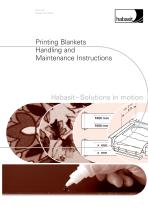
Printing Blankets Handling and Maintenance Instructions Habasit– Solutions in motion m . 2 ft ca 6
Open the catalog to page 1
Top-quality textile printing solutions _3 Precautionary measures / Safety provisions _4 • Joining on-site Immaculate printing blanket surface _13 Pretreatment with silica powder_14 Repairing of printing blankets with TPU _19 Repairing of printing blankets with resin 20 Selection of recommended adhesives, reducers and Product liability, application considerations If the proper selection and application of Habasit products are not recommended by an authorized Habasit sales specialist, the selection and application of Habasit products, including the related area of product safety, are the...
Open the catalog to page 2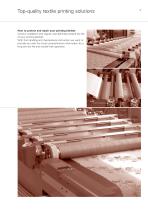
Top-quality textile printing solutions How to protect and repair your printing blanket Correct installation and regular care definitely extend the life of your printing blanket. With this handling and maintenance instruction we want to provide you with the most comprehensive information for a long service life and trouble-free operation.
Open the catalog to page 3
Precautionary measures Safety provisions Precautionary measures/Information Before starting installation, operation, or maintenance, please read the installation, operating and maintenance instructions carefully. These instructions contain information for the appropriate use of the printing blanket, and instructions to carry out installation and maintenance work in a safe and expert way. Open prepared printing blankets must be installed, drawn into the machine, and joined under the supervision of a Habasit technician or staff who has been trained for this job by Habasit specialists,...
Open the catalog to page 4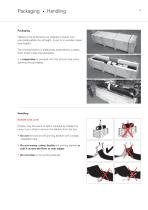
Packaging Habasit printing blankets are shipped in stable, nonreturnable pallets (by airfreight, truck) or in wooden cases (sea freight). The printing blanket is additionally protected by a plastic foam sheet inside the packaging. It is imperative to proceed with the utmost care when opening the packaging. Handling Handle with care! Employ only the piece of fabric supplied by Habasit by using it as a sling to remove the blanket from the box. • Do not remove and lift printing blanket with a single, unpadded rope • Do not crease, crimp, buckle the printing blanket or pull it across the floor...
Open the catalog to page 5
Transport Habasit printing blankets must be handled with extreme care. Avoid any damage. • Transport the printing blanket only in its original packaging, or on a Habasit coiling cart (e.g. CH-2400 or CH-2401) • Check condition of the Habasit printing blanket after each transport • When winding/transferring the printing blanket, make sure edges are flush (i.e. all coils are precisely placed one upon the other) • Store printing blankets in their original packaging • Protect from sunlight • Keep in a cool, dry place (not below –10 °C / 14 °F or above +25 °C / 77 °F, relative humidity between...
Open the catalog to page 6
Joining on-site Align rollers and cover up sharp parts/edges Insert prepared ends into press (Hot pressing a test sample if available. Control the joint and the bottom side) Hot pressing according to Habasit Joining Data Sheet Visual check of joint Cleaning and pretreatment of printing blanket surface with soap, water and silica powder
Open the catalog to page 7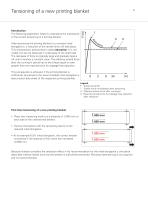
Tensioning of a new printing blanket Introduction The following explanation helps to understand the importance of the correct tensioning of a printing blanket. After tensioning the printing blanket to a constant initial elongation ε, a reduction of the tensile force will take place. This characteristic phenomena is called relaxation. It is not visible, but can be observed in a decrease of the shaft load. The decrease of force is originally large and gradually tapers off until it reaches a constant value. The effective tensile force after the running-in period has to be at least equal or...
Open the catalog to page 8
Tensioning of a previously tensioned printing blanket Introduction If a used printing blanket has to be removed (e.g. for machine revision work), the characteristic behavior of synthetic material when it is released from tension has to be considered. Immediately after the release (t0), the blanket contracts. During the so-called elastic recovery , the blanket contracts to a certain amount of its initial length only (lε), it does not reach its initial length (l0). After the elastic recovery, the belt still recovers gradually over a long time period. First the process is going on quite fast...
Open the catalog to page 9
“Tracking” refers to the procedure of adjusting a printing blanket so that it runs straight and stable (without any sideways movement) through the machine. Usually this is achieved through one or several of the following means: • Proper tensioning of the left and right edges of the blanket • Adjustable snub rollers on the return path • Fixed guiding blocks set against the edge of the printing blanket • Automatic tracking control devices with a sensor on the edge of the printing blanket, controlling a tracking roller Fixed guiding blocks as well as automatic tracking control devices should...
Open the catalog to page 10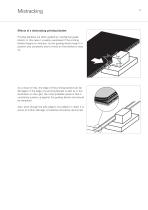
Effects of a mistracking printing blanket Printing blankets are often guided by mechanical guide blocks. In this case it is easily overlooked if the printing blanket begins to mistrack, as the guiding blocks keep it in position and constantly exert a force on the blanket to stay so. As a result of this, the edge of the printing blanket can be damaged. If the edge of a printing blanket is split as in the illustration on the right, the most probable cause is that it constantly pushes up against the guiding blocks and should be retracked. Also, even though the split edge is no problem in...
Open the catalog to page 11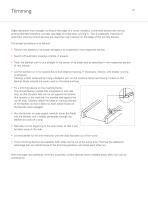
Slight deviations from straight running of the edge of a newly installed, untrimmed blanket are normal; printing blankets therefore normally are edge-trimmed after running in. This is especially important if automatic tracking control devices are used that use a sensor on the edge of the printing blanket. The proper procedure is as follows: • Tension the blanket to its proper elongation as explained in the respective section • Switch off automatic tracking controls, if present • Track the blanket until it runs straight in the center of its slider bed as described in the respective section...
Open the catalog to page 12All Habasit catalogs and technical brochures
-
Meat and Poultry Industry
24 Pages
-
Textile Industry
24 Pages
-
Bakery Industry
20 Pages
-
HabaSYNC® Wide Timing Belts
4 Pages
-
E-RB-F
2 Pages
-
Higher Chain Conveyor Speeds
4 Pages
-
NHM-10ELBV-E3
3 Pages
-
ENI-5EE
3 Pages
-
ENI-5P
3 Pages
-
ENI-12P
3 Pages
-
HabaSYNC Timing Belts
76 Pages
-
Habasit America
4 Pages
-
Specialty Belts & Components
2 Pages
-
HabaSYNC® WH-A-02
2 Pages
-
HabiPLZST Guides and Profiles
60 Pages
-
Habasit Cleandrive™
16 Pages
-
Habasit Crosslapper Belts
6 Pages
-
Material Handling Industry
20 Pages
-
Tape MVT-6P
2 Pages
-
MVM-5E Machine Tape
2 Pages
-
MAV-5E Machine Tape
2 Pages
-
Flexfold
2 Pages
-
HabaCHAIN
4 Pages
-
Details about Yarn Processing
28 Pages
-
Textile Industry
12 Pages
-
Confectionery Industry
22 Pages
-
HySAN Food Conveyor Belts
4 Pages
-
EU Food Regulations
6 Pages
-
Beverage Industry
34 Pages
-
Tire Industry
20 Pages
-
Automotive Industry
4 Pages
-
Airport Industry
12 Pages
-
GRABBER FFS Series
4 Pages
-
Habiblue
2 Pages
-
Product Guide HabasitLINK
306 Pages
-
Thermoplastic Extruded Profiles
19 Pages
-
HabaDRIVE
4 Pages
-
Habasit Spiral Belts
12 Pages
-
MNI-7E Machine Tape
2 Pages
-
Habasit Cleanline (4063)
12 Pages
-
Printing Blanket ENU-50AXBD
2 Pages
-
Habasit Fitline TMBE02404
4 Pages
-
Habasit Eff-Line belts
4 Pages
-
Habasit Cleanline
12 Pages
-
HabaCHAIN Product Guide
128 Pages
-
HabasitLINK®
100 Pages
-
Packaging Industry
26 Pages
-
Wood Industry (2055)
24 Pages
-
Tobacco Industry (2010)
16 Pages
Archived catalogs
-
Habasit Tire Industry (2036)
32 Pages
-
Habasit Yarn Processing (2006)
28 Pages
-
Habasit Bakery (2005)
28 Pages






















































































